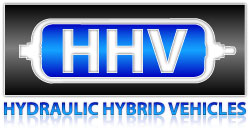Clean Automotive Technology
Hydraulic Hybrid Research

What Are HHVs?
Hybrid vehicles use two sources of power to drive the wheels. In a hydraulic hybrid vehicle (HHV) a regular internal combustion engine and a hydraulic motor are used to power the wheels.
Hydraulic hybrid systems consist of two key components: high pressure hydraulic fluid vessels called accumulators, and hydraulic drive pump/motors. The accumulators are used to store pressurized fluid. Acting as a motor, the hydraulic drive uses the pressurized fluid to rotate the wheels. Acting as a pump, the hydraulic drive is used to re-pressurize hydraulic fluid by using the momentum of the vehicle. This process converts kinetic energy into reusable potential energy and is called regenerative braking.
There are two types of HHVs: parallel and series. In parallel HHVs both the engine and the hydraulic drive system mechanically interact with the wheels. The hydraulic pump-motor is integrated into the driveshaft or differential. To learn more visit: How Parallel HHVs Work.
Series HHVs rely entirely on hydraulic pressure to drive the wheels, which means the engine does not directly provide mechanical power to the wheels. In a series HHV configuration an engine is attached to a hydraulic engine pump to provide additional fluid pressure to the drive pump/motor when needed. To learn more visit the page on How Series HHVs Work.
EPA and their partners have implemented both series and parallel HHV technology in multiple vehicles. To see some of these HHVs in action visit Demonstration Vehicles. EPA is evaluating this technology in light-duty vehicles with Chrysler. Visit our page on Light-Duty HHVs to learn more.
Why HHVs?
Series HHV technology significantly increases fuel economy and reduces emissions at negligible additional cost. Hydraulic technology is incredibly powerful and efficient for operations that require huge amounts of power. HHVs can perform not only as well as conventional vehicles, but also can be made to provide superior performance.
Hydraulic hybrid technology is versatile. HHV technology has been applied to military vehicles, buses, urban delivery trucks, refuse haulers, sports utility vehicles, family sedans and even a bicycle.To learn more visit our Hydraulic Hybrid Bike Page. Due to the highly efficient regenerative braking system and frequent engine off modes of operation HHVs make ideal urban vehicles where stop-and-go traffic is common.
The bottom line is that hydraulic hybrid technology is simple, clean, efficient and cost effective.
- Simple - The technology does not require breakthroughs to be cost effective or to be manufactured, and can be produced with the skills and manufacturing base already available in the U.S.
- Clean - It has proven to reduce emissions by up to 40 percent.
- Efficient - Series HHVs dramatically increase fuel efficiency from 60 percent to over 100 percent.
- Cost-effective - The low cost to manufacture combined with reduced brake maintenance and dramatically increased fuel efficiency results in thousands of dollars saved over the lifetime of the vehicle. This makes HHVs one of the best green technologies to invest in.
Why Are HHVs So Efficient?
Three key design features help full series HHVs achieve maximum fuel efficiency:
- Regenerative Braking. When braking, the HHV captures and stores energy from the wheels. When the vehicle starts accelerating, this stored energy is used to accelerate the vehicle. This process captures and reuses over 70 percent of the energy normally wasted during braking. This also reduces wear on the friction brakes.
- Shutting Engine Off When Not Needed. There is no conventional transmission and driveshaft connecting the engine to the wheels allowing the engine to be completely shut off when not needed. The engine is activated by a hybrid controller only when needed. As a result, engine use is nearly cut in half in stop-and-go urban city driving.
- Optimum Engine Control. Since the engine is not mechanically coupled to the drive wheels, a hybrid controller can command the engine, when needed, to operate at its maximum efficiency -- or "sweet" spot -- to achieve optimum vehicle fuel economy.
EPA's Role
EPA is on the cutting edge of research and development of hydraulic hybrid technology. EPA has achieved major breakthroughs in the design and operation of pump/motors and accumulators by making them smaller, lighter, and more efficient. These breakthroughs led to the development of applications for both large commercial and smaller consumer vehicles. The unique hybrid drivetrain design has also been combined with EPA's work on advanced, cleaner, and more efficient engines. To commercialize these breakthroughs EPA has cooperative research and development agreements with several private sector partners. Visit our Demonstration Vehicles page to learn more about vehicles that EPA has developed in cooperation with its industry partners. For additional information on the partnerships visit our Partnerships page.
